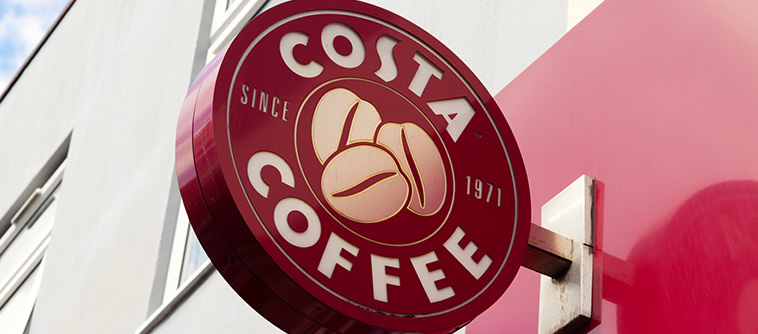
Coca-Cola’s swoop for Costa Coffee will cut its exposure to sugar and plastic bottles
Coca-Cola’s £3.9 billion acquisition of Costa Coffee has made quite a ripple. Atlanta-based Coca-Cola is obviously best known for its soft drinks portfolio, found in supermarkets, kiosks, hotels, bars and restaurants around the world.
Costa, headquartered in the UK, has 3,800 coffee shops in over 30 countries with about two-thirds in its UK home market. Both companies might be all about beverages, but that’s about the only overlap in their operations.
The logic for Costa’s current owner, Whitbread, is straightforward enough. It was coming under investor pressure to focus on its hotel business and get out of coffee. Its chief executive, Alison Brittain, says the price tag achieved a substantial premium over the alternative, which was to simply demerge it – Costa was previously valued at around £3 billion. A far more interesting and complex issue is what makes Costa so attractive to Coca-Cola that it was willing to pay such a premium.
Coke’s problems
The Coca-Cola Company has relied on its famous cola beverages for growth since its inception in 1892. The strength of the Coca-Cola brand – valued at almost US$70 billion (£54 billion) by Interbrand – has always been a double-edged sword. A small percentage of growth in cola could bring enormous dollar impact on revenue and profit, and therefore may be prioritised over brands with high growth potential, but smaller current sales volumes.
Coca-Cola has more than 500 soft drink brands, from Fuse Tea to Oasis to Lilt to Powerade, but none is anywhere close to the Coke brand in awareness, revenue and profit. When Coca-Cola’s chief executive, James Quincey, says he wants The Coca-Cola Company to be a total beverage company, he’s attempting to address this difficulty. Though the company already has a couple of minor coffee brands in particular countries, the Costa acquisition is on a different level: it communicates to everyone in the company and beyond that he is serious.
The unevenness of the portfolio is not the only reason for the total beverages strategy. The company’s strength is still primarily in sparkling carbonated drinks. Sales of carbonated drinks as a whole are still growing globally, but only at between 2% and 3%. And in developed markets such as the US, they’re declining. As people switch to healthier lifestyles, the worry is that this will start happening everywhere.
At the same time, global drinks growth has been primarily in still drinks – water, juice and coffee. Worldwide coffee sales are expected to grow at 6% a year for the next few years. Selling coffee to coffee drinkers will seem like an easier task than convincing them to drink Coca-Cola.
Then there is sugar. Soft-drink manufacturers have come under mounting pressure from governments and campaigners for the amount of sugar in their products. Some countries have introduced a tax on sugar. While it’s common to drink coffee with sugar, coffee is not in the firing line in the same way as fizzy drinks are.
True, Coca-Cola may be buying itself a new headache with the ethical issues that come with coffee farming. But Costa wins awards for its coffee ethics, so Coca-Cola does not appear to be buying someone else’s problem. The deal also increases the company’s exposure to drinks businesses that rely on raw ingredients whose price can be volatile – whereas the production price of Coca-Cola is pretty stable, a drink that relies on coffee beans is somewhat less so. No doubt the board would argue that the pros outweigh the cons, however.
Customer closeness
With Costa comes a plethora of capabilities The Coca-Cola Company does not yet possess. Costa is a retail company. It’s in the service business. It sells to consumers directly. Nespresso, another product that sells direct to consumers, was unique at Nestlé, which otherwise sold only to resellers like retailers and wholesalers. The experience of going direct with Nespresso, and what they learned in doing so, encouraged Nestlé to sell other products to consumers online.
Coca-Cola has a well developed network of third-party bottlers that manages manufacture, sales and distribution of its beverages (full disclosure: I have educational links with one of them). So when it comes to increasing the links between The Coca-Cola Company and its ultimate consumers, arguably it could benefit even more than Nestlé.
In sum, the intent of the acquisition looks well founded – access to growth, diversification, broadening of product portfolio, environmental and health benefits. But what about that premium?
Quincey says the company can create opportunities to grow the Costa brand globally. This would take it beyond its core UK presence to potentially more than 30 other countries.
Costa’s business model is primarily to franchise its stores rather than to own them directly. This is a business model Coca-Cola is very familiar with as it does the same with its bottler network. Leveraging the potential for these two sets of third parties to work together – for example, selling a broad portfolio of Coca-Cola’s brands in Costa locations – might add some complexity. But if there’s enough profit to go around, all issues can be resolved.
John W Walsh is Professor of Marketing at IMD.
This article was first published in The Conversation
Research Information & Knowledge Hub for additional information on IMD publications

Taking up a new leadership post can mean a dramatic shift in the way others see you – and how you define yourself. It is vital to learn how to separate your true self from the demands and expectations of the role.

Campaign failures at Apple, Bud Light, & Jaguar show why boards must prioritize marketing oversight. Insights from Su-mei Thompson.
BARCELONA, JANUARY 2023. What started in 2016 as a humble entrepreneurial attempt to contribute to a more sustainable future had turned into a solid eyewear brand present in major Western markets. François van den Abeele was even more excited by t...
As with most business opportunities, branding is essential to pioneering in sustainability. Only with branding can a company resist commoditization and obtain a premium price to compensate for the upfront investment and risk in making a major chan...
The Swiss start-up Planted makes plant-based meat substitutes with remarkable environmental benefits. Its “beef” requires 97% less CO2 and 81% less water than meat from cows, while its “chicken,” also from pea protein, involves 77% less CO2 and 81...
Consumer preferences are increasingly favoring brands with a strong local identity. The reasons for this trend include environmental concerns and challenges in our fast-paced, interconnected world. Global crises -- such as the COVID-19 pandemic, c...

Four tips to market to women more effectively and reach, engage and convert female consumers who make 80% to 85% of all purchasing decisions.

While it’s tempting for business leaders to think they can safely navigate a divisive cultural and political landscape, it’s a fool’s errand.
The case study delves into strategic transformation and leadership transitions at Unilever since 2009. Unilever has been an industry leader of business sustainability. Paul Polman was a pioneer who introduced the idea that, by addressing social an...

Marketing campaigns for sustainable offerings often fail, leaving businesses with products that do not sell. How can companies reach customers more effectively?
Research Information & Knowledge Hub for additional information on IMD publications
in I by IMD
Research Information & Knowledge Hub for additional information on IMD publications
Research Information & Knowledge Hub for additional information on IMD publications
in Binder, Julia Katharina (Ed.); Haanaes, Knut Bjarne (Ed.) / Leading the sustainable business transformation: A playbook from IMD, pp. 127-136 / Hoboken: Wiley, 2025
Research Information & Knowledge Hub for additional information on IMD publications
in Binder, Julia Katharina (Ed.); Haanaes, Knut Bjarne (Ed.) / Leading the sustainable business transformation: A playbook from IMD, pp. 151-165 / Hoboken: Wiley, 2025
Research Information & Knowledge Hub for additional information on IMD publications
in FamilyBusiness.org 28 October 2024
Research Information & Knowledge Hub for additional information on IMD publications
in I by IMD
Research Information & Knowledge Hub for additional information on IMD publications
in I by IMD
Research Information & Knowledge Hub for additional information on IMD publications
Research Information & Knowledge Hub for additional information on IMD publications
Research Information & Knowledge Hub for additional information on IMD publications

